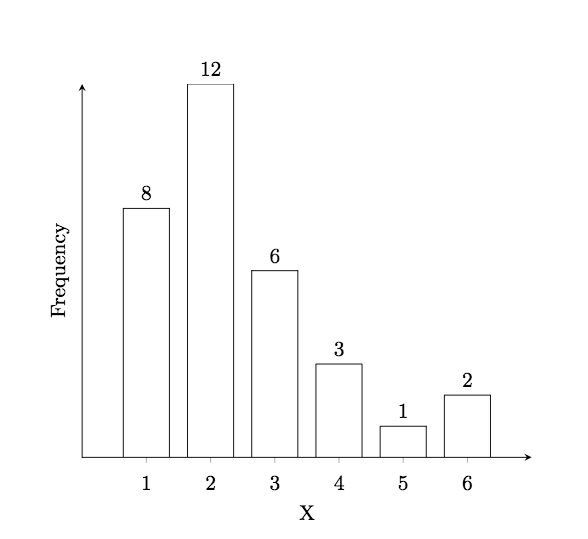Section 1.8 Visual Statistical Measures - Graphical Representation of Data
Data sets can range from small to very large. Visual representations of these data sets often allow you to see trends and reveal a lot about the distribution of the data values.
Subsection 1.8.1 Histograms
Frequency Histograms - height matters
Consider the data set given by
\(x_k\)
\(f_k\)
1
8
2
12
3
6
4
3
5
1
6
2
A frequency histogram representing this data looks like

Experiment with creating your own histogram by inputting your data into the interactive Sage cell below.
Relative Frequency Histograms - In this case, area describes relative frequency. Notice in the interactive cell above that each bar is of width one. Therefore, frequency = area. In some instances where data may be grouped the total width of the interval may be different and so the height will need to be adjusted so that the total area of each bar corresponds to the relative frequency of that category.
Cummulative Histograms. In these a running total is presented using all values from the given point and below.
Subsection 1.8.2 Stem and Leaf Plot
A Stem and Leaf Plot allows you to create a histogram of sorts but maintain the individual data values. To create one of these plots, you will need to consider your particular data set and create a two-step sieve for organizing the set. The first part is to create "stems" that are often associated with the highest digit(s) of each data value and the "leaves" that are often associated with the remaining digit(s) of the data value.
Once the data set is broken down into stems and leaves, it is often simple to sort the leaves under each stem to yield an "ordered Stem and Leaf Plot". Such as mechanism is a simple two-step procedure that allows you to sort a data set by hand.
Consider the data points 25, 3, 17, 12, 22, 34, 12, 11, 16, 42, 9, 12, 17. In this case we will consider the stems to be the tens digits and the leaves to be the ones digits. This gives
Stems
Leaves
0
3 9
1
7 2 2 1 6 2 7
2
5 2
3
4
4
2
Stems
Leaves
0
3 9
1
1 2 2 2 6 7 7
2
2 5
3
4
4
2
Notice, in each case you can extract the original data values by recombining the stem with a corresponding leaf. Indeed, for these 13 data values the median should be be 7th in the sorted list or the value in the 10's stem with leaf 6...that is, 16.
Example 1.8.5 Stem and Leaf Plot for State Populations
Using the state population data above, consider organizing the data but using a "two-pass sort" where you first roughly break data up into groups based upon ranges which relate to their first digit(s). In this case, let's break up into groups according to populations corresponding to 0-4 million, 5-9 million, 10-14 million, 15-19, million, 20-24 million, 25-29 million, 30-35 million, and 35-39 million. We can represent these classes by using the stems 0L, 0H, 1L, 1H, 2L, 2H, 3L, and 3H where the L and H represent the one's digits L in {0, 1, 2, 3, 4} and H in {5, 6, 7, 8, 9}. Once we group the data into these smaller groups then we can write the remaining portion of the number horizontally as leaves (in this case with one decimal place for all values.) This gives a step-and-leaf plot. If we additionally sort the data in the leaves then this gives you an ordered stem-and-leaf plot. For the state population data, the ordered stem-and-leaf plot is given by

Subsection 1.8.3 Box and Whisker Diagram (Box Plot)
This graphical display identifies the "5-number-summary" associated with the minimum, quartiles, and the maximum. That is, \(y_1, Q_1, Q_2, Q_3, y_n\text{.}\) These values separate the data roughly into quarters. To distinguish these quarters connect \(y_1\) and \(Q_1\) with a straight line (a whisker) and do the same with \(Q_3\) and \(y_n\text{.}\) Use a box to connect \(Q_1\) with \(Q_2\) and the same to connect \(Q_2\) with \(Q_3\text{.}\) Then the boxed areas also identify the IQR.
Subsection 1.8.4 Density Plots
A Density Plot can be created to visually interpret if the variable is close to normal
www.machinelearningplus.com